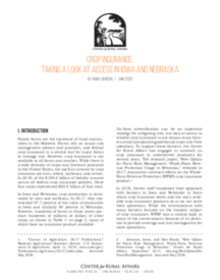Farm and Food
Family farms are the backbone of rural communities in the Midwest. Farms rely on sound risk management options and practices, and federal crop insurance is a central tool for many farms to manage risk. However, crop insurance is not available to all farms and ranches. While there is a wide diversity of crops and livestock produced in the United States, the top four covered by crop insurance are corn, wheat, soybeans, and cotton. In 2019, of the $109.6 billion of liability insured across all federal crop insurance policies, these four crops represented $80.8 billion of that total.
In Iowa and Nebraska, crop production is dominated by corn and soybeans. In 2017, they represented 97.7 percent of the value of production in Iowa and similarly 90 percent in Nebraska. In 2017, they represented 97.7 percent of the value of production in Iowa and similarly 90 percent in Nebraska. However, hundreds of farms in those states produce hundreds of millions of dollars of other crops.
On-farm diversification can be an important strategy for mitigating risk, but lack of access to reliable crop insurance is one reason many farmers avoid incorporating additional crops into their operation.
In Iowa and Nebraska, crop production is dominated by corn and soybeans. In 2017, they represented 97.7 percent of the value of production in Iowa and similarly 90 percent in Nebraska. In 2017, they represented 97.7 percent of the value of production in Iowa and similarly 90 percent in Nebraska. However, hundreds of farms in those states produce hundreds of millions of dollars of other crops.
On-farm diversification can be an important strategy for mitigating risk, but lack of access to reliable crop insurance is one reason many farmers avoid incorporating additional crops into their operation.


